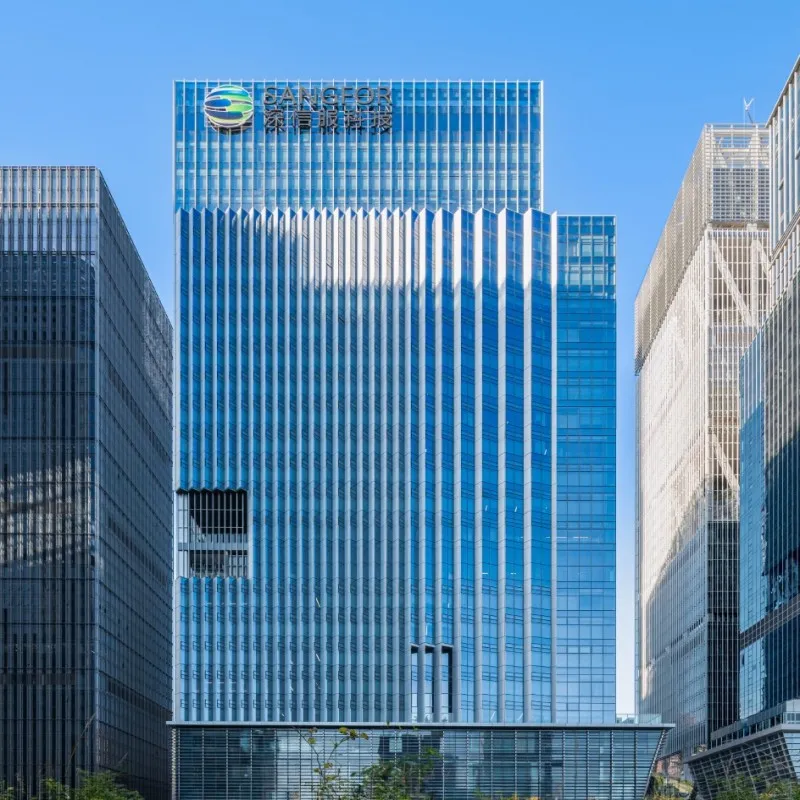What is Data Center Architecture?
Data center architecture refers to the comprehensive design of computing, storage, networking, and power infrastructure that supports modern IT operations. It includes both physical components (servers, cooling systems, security measures) and logical components (virtualization, software-defined networking, automation). A well-structured architecture ensures high availability, security, energy efficiency, and scalability to meet growing business demands.

Importance in Modern IT Infrastructure
- Foundation for Digital Transformation: Modern data centers enable cloud computing, AI and IoT adoption through scalable infrastructure and hybrid cloud architectures. They support everything from enterprise systems to digital services while balancing performance and cost-efficiency.
- Powering Advanced Workloads: Specialized hardware like GPU clusters accelerates AI training and real-time analytics, driving breakthroughs in healthcare, finance and autonomous systems. Optimized architectures reduce processing times from weeks to days for complex computations.
- Ensuring Business Resilience: Geographic distribution and automated failover maintain operations during outages. Advanced monitoring predicts failures before they occur, crucial for industries where downtime costs millions hourly.
- Driving Sustainable Operations: Innovations like liquid cooling and AI-powered energy management reduce environmental impact. These solutions lower both carbon footprints and long-term operational costs through improved efficiency.
- Enabling Edge Computing: Decentralized architectures bring processing closer to users for latency-sensitive applications. This supports real-time automation while addressing bandwidth constraints and data sovereignty requirements.
Key Components of Data Center Architecture
Physical Infrastructure
- Building & Space Design:
- Tiered layouts (hot/cold aisle containment) for optimal airflow.
- Modular data centers for rapid deployment and expansion.
- Power & Cooling Systems
- Uninterruptible Power Supply (UPS) and backup generators for uptime.
- Liquid cooling & free-air cooling for energy efficiency.
- Security & Safety:
- Biometric access, surveillance, and fire suppression (e.g., FM-200 systems).
Networking Infrastructure
- Core Layer: High-speed backbone for interconnecting data center segments.
- Aggregation Layer: Provides load balancing, firewalls, and VLAN routing.
- Access Layer: Connects servers and storage to the network.
- Emerging Trends:
- Software-Defined Networking (SDN) for dynamic traffic management.
- Spine-Leaf Architecture for low-latency, high-bandwidth East-West traffic.
Storage Systems
- Cloud Storage (AWS S3, Azure Blob): Scalable, cost-effective for unstructured data.
- On-Premises Storage (SAN/NAS): High-speed, low-latency for critical workloads.
- Hybrid & Software-Defined Storage (SDS): Combines flexibility with performance.
Computing Resources
- Virtualization (VMware, Hyper-V): Maximizes server utilization.
- Containerization (Kubernetes, Docker): Enhances portability and scalability.
- Bare-Metal Servers: Used for high-performance computing (HPC) and AI workloads.
Management & Automation
- AI-Driven Monitoring: Predictive analytics for failure prevention.
- Automated Resource Allocation: Ensures optimal workload distribution.
Types of Data Center Architectures
Traditional Data Center Architecture
Traditional architecture follows a three-tiered design with core, aggregation, and access layers, using physical servers and dedicated networking equipment. This approach provides clear segmentation but can be less flexible. It's commonly used by enterprises running legacy applications that require dedicated hardware and predictable performance.
Cloud-Based Data Center Architecture
Cloud-based architecture relies on virtualization to create scalable, on-demand resources with a pay-as-you-go model. This eliminates the need for physical hardware ownership while providing elastic scalability. It's ideal for SaaS providers, web applications, and big data analytics that experience variable workloads.
Hyper-Converged Infrastructure (HCI)
HCI integrates compute, storage, and networking into a single software-defined system running on commodity hardware. This simplifies management while improving resource utilization. Mid-sized businesses often adopt HCI for virtual desktop infrastructure (VDI) and other consolidated workloads needing streamlined operations.
Edge Data Centers
Edge data centers decentralize processing by locating smaller facilities closer to end-users. This architecture minimizes latency for time-sensitive applications. It's becoming essential for IoT networks, 5G services, autonomous vehicles, and other real-time systems requiring immediate data processing.
Modular Data Centers
Modular designs use prefabricated, portable units that can be rapidly deployed and scaled as needed. These self-contained modules include all necessary infrastructure components. They're particularly valuable for military operations, disaster recovery scenarios, and temporary capacity expansion where speed and mobility are critical.
Design Principles & Standards of Data Center Architectures
Uptime Institute's Tier Classification System
The Uptime Institute's tier classification provides a standardized framework for evaluating data center reliability and performance:
Tier I (Basic Infrastructure)
- Availability: 99.671% (28.8 hours downtime/year)
- Redundancy: Single path for power and cooling
- Best For: Small businesses with basic IT needs and limited budgets
Tier II (Redundant Components)
- Availability: 99.741% (22 hours downtime/year)
- Redundancy: Partial redundancy in power/cooling
- Best For: Growing mid-sized enterprises needing improved reliability
Tier III (Concurrently Maintainable)
- Availability: 99.982% (1.6 hours downtime/year)
- Redundancy: Multiple independent distribution paths
- Best For: Financial institutions, healthcare providers, and enterprises requiring high availability
Tier IV (Fault Tolerant)
- Availability: 99.995% (26.3 minutes downtime/year)
- Redundancy: 2N+1 fully redundant systems
- Best For: Hyperscale operators and mission-critical applications where downtime is unacceptable
Key Design Considerations
Modern data center design focuses on four critical pillars:
- Scalability: Future-proof designs incorporate modular expansion capabilities and adaptable network topologies like spine-leaf architecture to accommodate growth without service disruption.
- Redundancy: Strategic implementation of N+1 or 2N redundancy for power, cooling, and network paths ensures continuous operation during component failures or maintenance.
- Energy Efficiency: Optimization through Power Usage Effectiveness (PUE) metrics drives innovations in cooling technologies, renewable energy integration, and workload placement strategies.
- Security: Comprehensive protection combines zero-trust network principles with hardware encryption and multi-layered authentication protocols to safeguard physical and digital assets.
Network Topologies Compared
Three-Tiered Architecture (Core-Aggregation-Access)
Advantages:
- Simple hierarchical structure that's easy to understand and manage
- Clear separation of functions between layers
- Cost-effective for traditional enterprise deployments
Limitations:
- Potential bottlenecks at the core layer during peak traffic
- Limited scalability due to fixed hierarchical design
- Less efficient for East-West traffic between servers
Ideal Use Cases:
- Conventional enterprise networks
- Organizations with predominantly North-South traffic patterns
- Environments requiring straightforward network management
Spine-Leaf Architecture
Advantages:
- Flat architecture enables low-latency communication
- Excellent scalability through additional spine or leaf switches
- Optimized for East-West traffic flows common in modern applications
Limitations:
- Requires more sophisticated configuration and management
- Higher initial implementation complexity
- Potentially higher costs for high-speed interconnects
Ideal Use Cases:
- Cloud service provider environments
- Hyperscale data centers
- Virtualized and containerized workloads
- Software-defined networking deployments
Fat Tree Topology
Advantages:
- Non-blocking architecture provides full bisection bandwidth
- Excellent for high-performance computing requirements
- Multiple parallel paths prevent congestion
Limitations:
- Significant cabling requirements increase costs
- Complex physical implementation
- Higher power consumption due to more active components
Ideal Use Cases:
- High-performance computing clusters
- AI/ML training environments
- Scientific research facilities
- Financial trading systems requiring ultra-low latency
Each topology offers distinct advantages that make them suitable for different operational requirements, with the choice depending on factors like traffic patterns, performance needs, and scalability requirements. Modern data centers often combine elements of these topologies to create hybrid solutions that balance performance, cost, and manageability.
Challenges & Solutions in Data Center Architecture
Addressing common challenges in data center architecture is crucial for maintaining operational efficiency and security.
High Energy Costs
Challenge:
Data centers consume massive amounts of electricity for power and cooling, leading to soaring operational expenses and environmental concerns.
Solutions:
- Liquid cooling systems that are 90% more efficient than air cooling for high-density racks
- Renewable energy integration through solar/wind power and power purchase agreements (PPAs)
- AI-optimized cooling that dynamically adjusts based on real-time workloads (like Google's DeepMind implementation)
- Waste heat recycling to warm nearby buildings in cold climates
Security Threats
Challenge:
Increasingly sophisticated cyberattacks including ransomware, DDoS, and supply chain vulnerabilities targeting critical infrastructure.
Solutions:
- Zero Trust Architecture with continuous identity verification and least-privilege access
- AI-powered threat detection that analyzes network patterns to identify anomalies
- Hardware-based security with TPM chips and confidential computing
- Automated patch management systems to eliminate vulnerability windows
Legacy System Integration
Challenge:
Aging infrastructure that can't support modern workloads while maintaining compatibility with existing systems.
Solutions:
- Hybrid cloud bridges that seamlessly connect on-prem and cloud environments
- Software-Defined Networking to abstract legacy hardware limitations
- Containerization wrappers to modernize legacy applications
- API gateways that enable communication between old and new systems
Skill Shortages
Challenge:
Lack of qualified professionals to manage increasingly complex data center technologies.
Solutions:
- AIOps platforms that automate routine monitoring and troubleshooting
- Self-healing infrastructure that autonomously resolves common issues
- Augmented reality (AR) maintenance guides for complex repairs
- Cloud-based management consoles that simplify operations through centralized control
Future Trends in Data Center Architecture
Staying updated with future trends ensures that data centers remain relevant and efficient in the evolving technological landscape.
- AI-Optimized Data Centers: AI is transforming operations through self-healing networks and predictive maintenance. Machine learning optimizes workload distribution and energy use, boosting efficiency by 30%. These smart systems automatically detect and resolve issues before they impact performance.
- Quantum Computing Prep: Data centers are adopting quantum-resistant encryption to counter future threats. Hybrid quantum-classical systems are emerging for specialized tasks. This includes testing quantum key distribution for ultra-secure communications.
- Green Data Centers: Innovations like immersion cooling cut energy use by 90%. Operators are integrating solar/wind power and heat reuse systems. Major providers are committing to carbon-neutral operations through these sustainable solutions.
- Edge Computing Growth: 5G expansion is driving micro data center deployments. These compact facilities enable low-latency processing for IoT, smart cities and autonomous vehicles. Cloud providers are offering specialized edge hardware for distributed computing.
- Advanced Hardware: New technologies include chiplet-based servers and dedicated Data Processing Units. Robotic maintenance systems are enabling unmanned operations. These innovations deliver higher performance with better energy efficiency.
Conclusion
Data center architecture is evolving rapidly to support AI, edge computing, and sustainability. Organizations must adopt modular, software-defined, and energy-efficient designs to stay competitive. The right architecture ensures scalability, security, and cost-effectiveness in an increasingly digital world.
Frequently Asked Questions
Tier IV offers fault tolerance (2N+1 redundancy), while Tier III is concurrently maintainable.
It enables dynamic traffic routing, automation, and better security policies.
No—they complement them by reducing latency for IoT and 5G applications.
Balancing scalability, security, and sustainability while managing costs.





